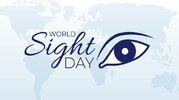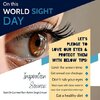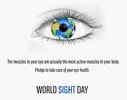World Sight Day is observed every year on the second Thursday of October, falling on October 12 this year. It was initiated by the Lions Clubs International Foundation during their ‘SightFirstCampaign’ in an effort to spread awareness about preventable blindness and help people who are visually impaired.
HISTORY OF WORLD SIGHT DAY
In 1917, Melvin Jones established Lions Clubs International (L.C.I.), which was a service organization. The Lions Clubs International has organized a variety of projects across the globe like fundraisers for typhoons and cyclone victims, diagnosis and management for people with hearing disorders, community hearing, and cancer screening projects.
One of the well-known Lions Clubs International projects was the ‘SightFirst’ campaign. Started in 1990, this campaign aimed to fight blindness due to trachoma and other causes of blindness. These campaigns helped over 488 million people who were visually impaired.
During the ‘SightFirst’ campaign in 2000, the Lions Clubs International and the International Agency for the Prevention of Blindness (I.A.P.B.) proclaimed every second Thursday of October to be observed as World Sight Day. The primary objective was to draw the public’s attention to the importance of following safe practices to prevent blindness and other problems related to vision. Medication kits and financial assistance were provided to the needy. This day was observed by millions of people worldwide to spread awareness about eye care and also to appreciate the gift of vision, which is a blessing in every sense of the word. This day was also a step towards the World Health Organization’s ‘VISION 2020’, which aimed to “intensify and accelerate prevention of blindness activities so as to achieve the goal of eliminating avoidable blindness by 2020.”
In 2020, World Sight Day was celebrated with a theme named ‘HopeInSight’ and over 755 World Sight Day events were organized in about 140 countries worldwide.
5 FACTS ABOUT EYES THAT WILL BLOW YOUR MIND
Eyes developed millions of years ago
It is estimated that eyes developed in mammals about 500 million years ago.
They are crucial for information
Almost 80% of the information that your brain processes comes from the eyes.
They are the fastest muscle
Contracting in less than 1/100th of a second, the eyes are the fastest muscle in the human body.
A blink lasts 100 milliseconds
The blink of a human eye can last anywhere between 100 to 150 milliseconds.
A sight test can determine other ailments
Conditions like high blood pressure or high sugar levels can be detected in an eye test.
WHY WE LOVE WORLD SIGHT DAY
Millions of people do not have access to medical care
It is said that half of the world's population does not have access to proper medical care and resources. It is important for people to recognize the gravity of the situation and do their part in helping people to obtain the medical supervision they are entitled to. This day draws attention to the fact that 85% of blindness is preventable and yet millions are visually impaired because they didn't receive treatment.
It is a reminder that sight is a gift
We have to realize that we wouldn't be enjoying the world's beauty, its color, and its detail if it were not for our eyes. We often take our eyesight for granted and become careless, not realizing that sight is truly a gift that we have to be grateful for. This day reminds us to take care of our eyes and also to show love and support to those who can't see.
It is a reminder to get your eyes checked
We often get so busy with our daily schedule that we neglect our bodies. Do you know that detecting cataracts in the early stages can help prevent blindness? This day provides an opportunity and a reminder to finally get that eye check you've been postponing for long.




